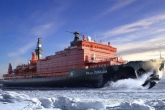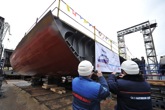New nuclear-powered icebreakers poised to change the game at Northern Sea Route

the keel of the first vessel of the new-generation icebreaker was laid at Baltiysky zavod wharf in November. Source: Press photo
Russia has begun building a fleet of new-generation icebreakers to support year-round navigation along the 3000-mile long Northern Sea Route. In a milestone of sorts, the keel for the first vessel of the three-ship series was laid at St. Petersburg’s Baltiysky Zavod wharf in November. “Not only does it symbolise a resurrection of Russia’s civilian nuclear-powered shipbuilding, it also ensures that even in 40 to 50 years to come, our nuclear icebreaker fleet will continue working effectively in the Arctic and along the Northern Sea Route,” says Atomflot CEO Vyacheslav Ruksha.
The first ship will be operated by Atomflot, Rosatom State Nuclear Energy Corporation’s arm responsible for the operation of Russia’s nuclear-powered icebreaker fleet. Atomflot currently operates four such icebreakers: Vaigach, Taimyr, Yamal, and 50 LyetPobyedi. It has one ship in reserve: Sovetskiy Soyuz.
Russia’s 10th icebreaker
Russia’s first nuclear-powered icebreaker, Lenin, was built during the Soviet days more than five decades ago. After its retirement the ship was turned into a museum in Murmansk. Three more Soviet-built nuclear-powered icebreakers - Arktika, Sibir, and Russiya - have also been written off by now.
The icebreaker under construction at Baltiysky Zavod has no name as yet. It will become the 10th nuclear icebreaker to be built since Russia’s independence. Rosatom deputy CEO Ivan Kamenskykh, who attended the keel-laying ceremony, said construction of the other two ships in the series would begin shortly. Over $4 billion has been allocated for the entire project, which will take 10 years to complete.
“The key feature of the new icebreaker [design] is its versatility,” says Atomflot representative Sergey Maklakov. “It will be able to operate both in deep-sea areas of the Northern Sea Route and in shallow shelf and estuary waters near the Arctic coast.” Thanks to this versatility, each vessel of the new design is expected to replace two icebreakers currently in operation. Atomflot is planning to mainly use its three new ships in the Western section of the Northern Sea Route to support large freight vessels, including bulk carriers from China, South Korea, and Japan.
Growing traffic
The keel-laying ceremony comes on the heels of a very symptomatic report: freight transit along the Northern Sea Route in 2013 has beaten a long-standing record. According to Atomflot spokesman Mustafa Kashka, 1.26 million tonnes had been transported along the route by mid-October, which is comparable to the result attained in all of 2012. Kashka says 51 vessels have navigated the route since the beginning of 2013, against 46 in all of 2012 and only 34 in 2011.
The first two foreign commercial vessels to navigate the Northern Sea Route, in 2009, were the Beluga Fraternity and the Beluga Foresight. Supported by the icebreakers 50 Lyet Pobyedi and Rossiya, they safely passed from South Korea to their Nigerian port of destination; a traditional route via the Suez Canal would have taken them 10 days longer. Next year, eight to 10 Chinese-flagged ships may use the Northern Sea Route.
A corridor of new opportunities
Today the traffic through high latitudes is only 10 percent of that passing through the Suez Canal. But experts say that the situation is going to change as the shortcut between the European markets and those of the Asia-Pacific region passes through the Arctic, and this is a great opportunity to optimise transportation costs. When proceeding through high latitudes, the distance is reduced by one-third (34 per cent) compared to the so called reference route Rotterdam-Yokohama across the Indian Ocean. The travel time is reduced from 33 to 20 days. The fuel economy is up to 800 tonnes per “average” vessel.For the development and operation of the next–generation highway, Russia is not only building new icebreakers, but is also planning to make a special law on the navigation on the Northern Sea Route that will eliminate many questions, including those related to tariffs on ice wiring. “The Northern Sea Route could be one of the key global transport routes - Russian leader Vladimir Putin assured the leaders of other countries on the forum called ‘The Arctic – a dialogue zone.’ But only if we manage to create a competitive environment for traditional maritime lines at the cost of their services, quality and safety”.
And here you can’t do without a well-functioning icebreaker fleet - no matter what climatologists predict.
All rights reserved by Rossiyskaya Gazeta.
Subscribe
to our newsletter!
Get the week's best stories straight to your inbox

